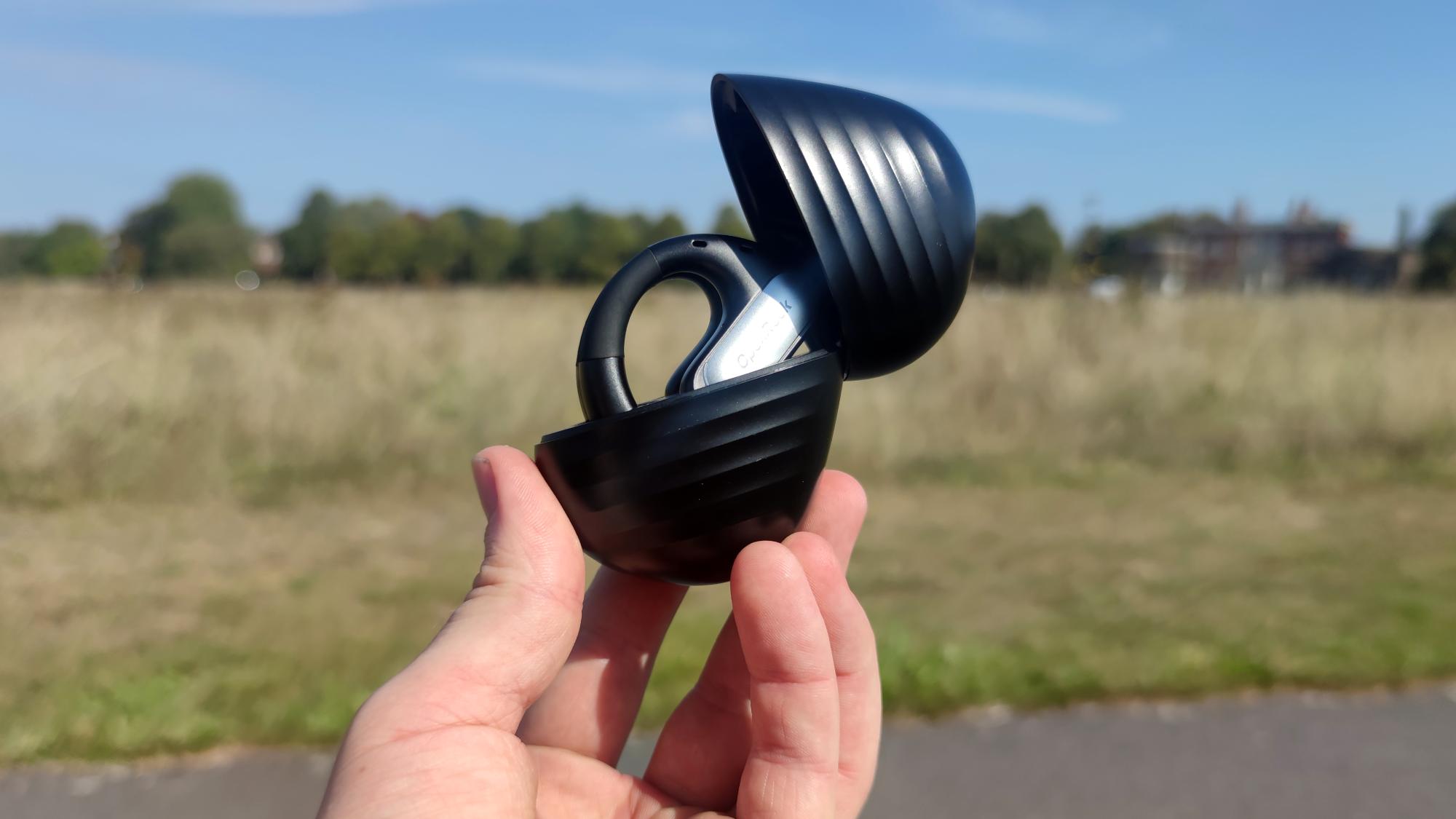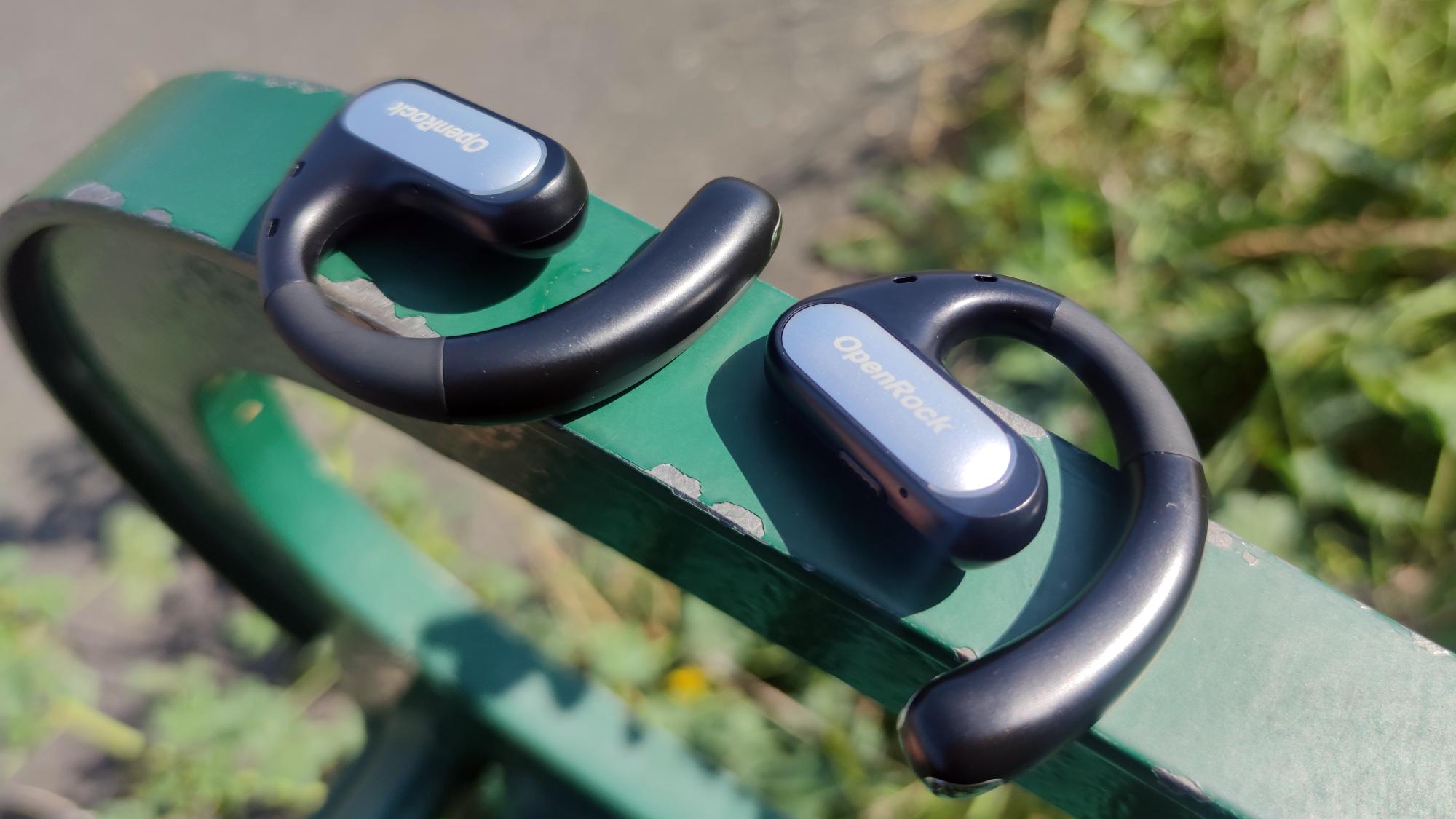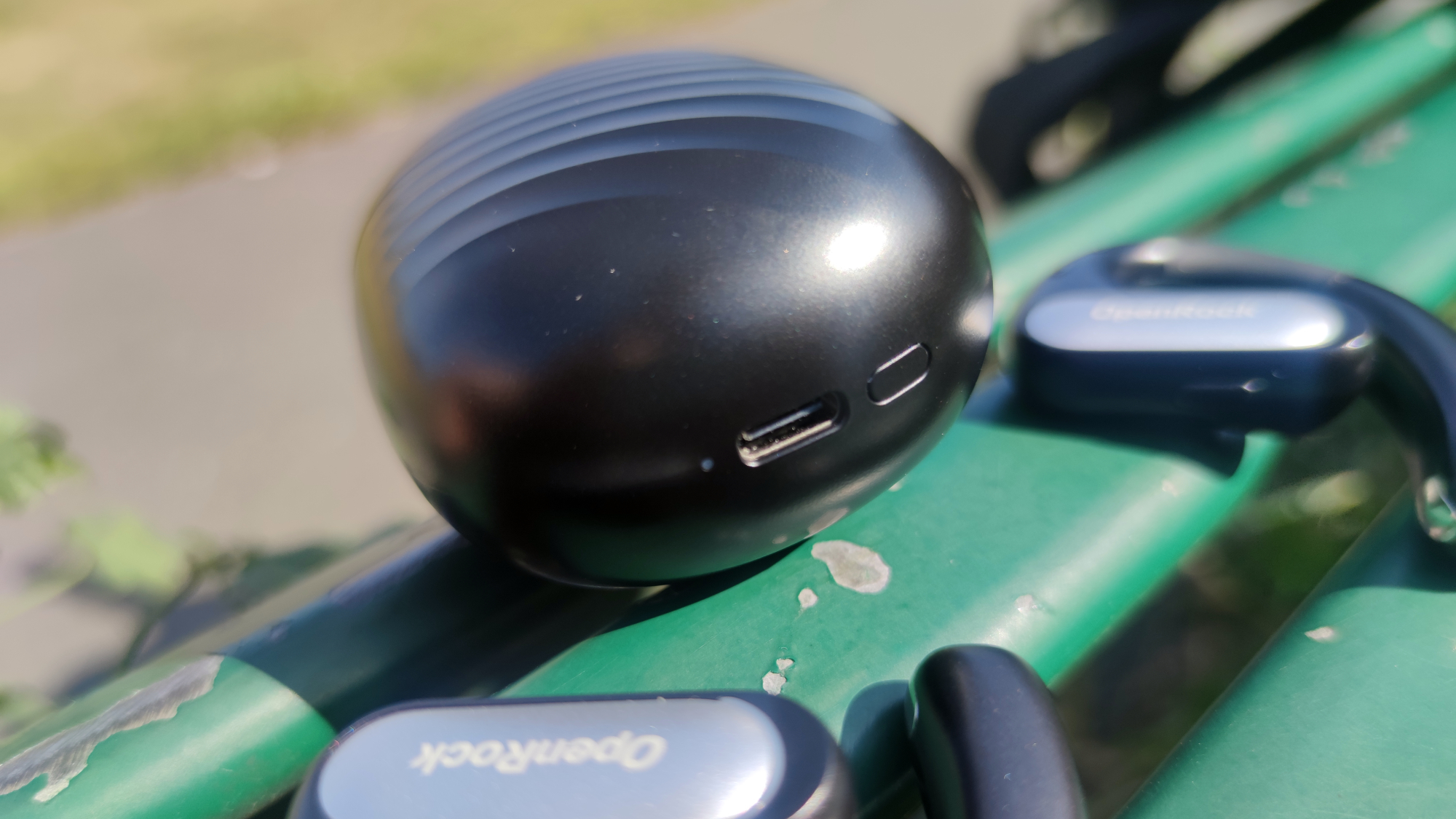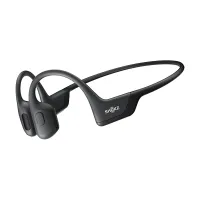TechRadar Verdict
The OpenRock Pro are certainly impressive as sports earphones go: they have a staggering battery life, a low price and one of the most comfortable fits you’ll find in this kind of product. However the audio quality of the OpenRock Pro might put off audiophiles, and if you're not sold on air conduction, these headphones won't win you over.
Pros
- +
Competitive price
- +
Comfortable fit
- +
Long battery life
Cons
- -
Middling audio
- -
Air conduction isn’t perfect
- -
Buds can pull hair
Why you can trust TechRadar
OpenRock Pro: One minute review
In the competitive world of fitness headphones, one of the problems many manufacturers are trying to solve is how you can listen to music but be aware of your surroundings; while the likes of the Shokz OpenRun Pro offer bone conduction and the AirPods Pro 2 offer Transparency mode, OneOdio has opted for a different option with its OpenRock Pro sports earphones.
The OpenRock Pro uses what is known as ‘Air Conduction’, which takes an open-ear design (in which the earbud sits above, but not in, your ear) but uses tech to channel the sound into your ear – OneOdio here goes for its own TubeBass solution to boost the bass, ostensibly giving better audio quality compared to other equivalent solutions.
So, does it work? Well, partly; while the overall audio experience isn’t perfect, OneOdio has managed to make some of the best earbuds for sports users thanks to all the features on offer and their fantastic design.
The OpenRock Pro are some of the most comfortable workout earbuds we’ve tested: they’re lightweight and fit well, so it’s easy to forget you’re wearing them, yet there’s no risk of them flying out mid-run, stretch or cycle.
The battery life is staggering. The buds alone will last 19 hours before needing to be charged, and the case for them bumps that figure up to 46 hours. Given that many rival headphones have 9-hour battery lives, the OpenRock Pro might be some of the only real options for people who want to do long-distance hikes, ultramarathons, or other lengthy undertakings.
Plus, OneOdio has priced these buds very competitively, with the rough $119/£119 (around AU$185) price tag undercutting lots of big-name fitness rivals from brands like Apple, JBL, Jaybird, and Jlab.
So what’s not to love? Well, the audio quality for one – while these sound fine for open-ear earphones, the audio quality just doesn’t compare to other workout buds you might be looking at that use over-ear or in-ear options.
Sign up for breaking news, reviews, opinion, top tech deals, and more.
Audio can sound quite tinny, with bass definitely lost in the mix given OneOdio’s focus on bass. Sure, you can’t expect fully balanced audio in headphones like this, but at the end of the day, fitness fans don’t actually have to consider air-conduction buds.
Overall, though, these are fantastic sports earphones that deliver across a range of activities, including cycling, running, and working out, so they’re well worth considering if you need new fitness friends.
OpenRock Pro review: Specifications
| Component | Value |
| Water resistant | IPX4 |
| Battery life | 19 hours (earbuds), 46 hours (total) |
| Bluetooth type | Bluetooth 5.2 |
| Weight | 13g / Charging case: 64g |
| Frequency response | 20Hz-20kHz |
OpenRock Pro review: Price and availability

- Cost $129.99 / £119.99 (roughly AU$185)
- Worth shopping around to find value options
- Fairly affordable compared to similar-tech rivals
The OpenRock Pro was unveiled in January 2023 and was available to buy shortly afterward.
You could buy the buds for launch at $129.99 / £119.99, but at least in the UK, that price varies a lot by where you look. At the time of writing Amazon UK still sells it for that price, but OneOdio offers it for a little less and the OpenRock website has it for £164! So shop around before you buy. In the US, the price seems to be more consistent.
At that price, the OpenRock Pro are fairly affordable for what they offer. They’re priced similarly to the Shokz OpenRun bone conduction buds, though if you look outside of the conduction sphere of exercise audio solutions, you’ll find that many alternatives from JBL, Jaybird, or Samsung are a little pricier.
Even similar air conduction buds like the Shokz OpenFit cost more, as that similar rival will set you back $179.95 / £179.99 / AU$289. Of course, you can find much cheaper alternatives (both air conduction and standard workout buds) on Amazon if you want but don’t expect a good fit or half-decent audio quality if you opt for those.
- Value score: 3.5/5
OpenRock Pro review: Design

- Comfortable and sturdy fit for sports
- Handy button for mid-workout controls
- Long-haired users may find hair pulling
The OpenRock Pro are True Wireless Earbuds, which means they are two individual buds that aren’t connected to each other or your phone by any kind of wire. The earphones have hooked designs, like many other sports earbuds, to loop around your ear for a comfortable fit.
And the fit certainly is comfortable – the OpenRock Pro are perhaps some of the best sports earbuds we’ve tested in terms of wear. At only 13g apiece they’re light enough that you can barely feel them attached to your body, yet the fit is sturdy enough that the buds don’t wobble or shake, no matter what kind of workout you’re doing, while the material of the hook ensures it doesn’t create a painful rub on your ear.
We frequently forgot that we were wearing the buds in the first place, which is something you can rarely say about the majority of tight or grippy sports headphones. That was even true in rain, which can cause even the sturdiest buds to slip and slide.
The solid fit is doubly important for air conduction tech, as the buds don’t actually sit in your ear – they instead position the speaker over it, for reasons we’ve already explained. The buds are very easy to adjust in a variety of ways too, so you should be able to find the ideal fit regardless of your ear shape.

Each bud has a button on it, and you can use these to answer calls, pause or skip around songs for music or change volume, with long presses or double (or triple) taps giving you a wide range of options. These controls at your fingertips can take a while to get used to, but if you’re picky about music (or receive plenty of calls) you’ll quickly become a master.
The buds themselves are IPX5 rated, and that means that they’re protected from water streams – they’re therefore totally sweat-proof, though you may not want to take them for a dip in a pool.
One minor issue we had with the buds was that they each had a silver bump surrounded by an ingress at the end of each hook, and this frequently caught our hair when we were putting on or taking off the buds. Frequently, we removed them to find that they’d pulled a hair or two out – this issue was mitigated when we had a haircut midway through the testing process, but it’s something to bear in mind for people with medium or long hair.
When you’re not using the OpenRock Pro, you’ll house them in their case, which is a large egg-shaped construct that you also use for charging. This is huge due to the size of the battery in it, which could lead to it being unwieldy, but luckily you don’t need to take it with you when you’re working out with the buds.
- Design score: 4.5/5
OpenRock Pro review: Features

- Air conduction tech works fairly well
- Wind can ruin your listening experience
- Absolutely massive battery life
The OpenRock Pro uses air conduction technology – if you’re not up on your fitness audio terms, and haven't read the introduction to this review, it basically means that the buds hang a speaker just over your ear canal, and channel the audio so that it’s delivered straight into your ears.
The purpose of this is that it lets you enjoy your audio without drowning out background noises, a useful function for runners or cyclists on the road or in potentially hazardous environments.
For the best part, this works well – when testing the buds we could easily hear vehicles behind us, honking horns, sirens from emergency vehicles and beeps from pedestrian crossings. Other people’s conversations didn’t quite make it through, so you’ll miss out on spoken words from nearby people, but if they raise their voices you’ll catch what they say.
The buds also do very little to cut out the sound of weather like rain or wind, so if you’re in a gusty or stormy area – or simply just run or cycle quickly – you’ll sometimes struggle to hear a podcast or call over the sounds.
At least in calls, your conversation partner can hear better – the OpenRock has noise cancellation for speech, ensuring that others can’t hear background noise around you during a call.

The OpenRock Pro’s battery life makes it a must-have for fans of long-distance or endurance exercises. According to OneOdio, the buds themselves will last for 19 hours of use before needing to be recharged, and the case itself can hold up to 46 hours of listening. Although we imagine the vast majority of people don’t need to listen to music for two straight days between charges, this ensures that you’ll be able to keep listening to tunes for multiple days on an expedition without needing to worry about power.
Powering is done via a USB-C port in the OpenRock Pro’s case. It’s quick to charge, with OneOdio stating that 5 minutes of power will give you 60 minutes of listening time. A full charge will take you around four hours.
The buds are fairly easy to pair with your phone, thanks to the control button on the Pro’s case – upon initial pairing, you simply press this when scanning for Bluetooth connections on your chosen device to pair. After that, simply removing the OpenRock Pro from its charging case connects it to your device, in a process that’s simple and smooth and, during the testing period, never failed.
That solid connection occurred for the most part during our tests – occasionally audio dropped from one earbud for a couple of seconds, but it quickly reconnected and we rarely lost both channels.
- Features score: 4/5
OpenRock Pro review: Performance

- Great sound for open-ear design
- Comfortable once you get the fit right
- 7 hours of battery in the buds and 28 hours with the case
We’ve got to write a seemingly contradictory statement here: the OpenRock Pro has some of the best audio we’ve heard from air conduction headphones, but also some of the worst we’ve heard from fitness headphones at this price point.
By virtue of the way air conduction works, with the buds hanging over your ear canals instead of sitting in or over them, sound quality is never going to be as good as with in-ear or over-ear solutions.
The vast majority of three-figure-price-tag fitness headphones or earbuds on the market sound better than these buds, however, the OpenRock Pro do sound better than most other air-conduction headphones we’ve tested from other brands. So if you really want to use headphones with this tech, the OpenRock Pro should be your first port of call.
OneOdio’s TubeBass ostensibly improves the bass sound quality, and while this does offset one issue of air conduction, it just highlights that there's a very limited sound stage here. Treble and bass are both palpable, but they sit so close together that you can't always work out which is which.

The max volume isn't too high either, and while this protects your ears (and saves on sound leaking), it does mean that in areas with lots of traffic or background noise, you might struggle to catch words in an audiobook or podcast.
These issues won't matter to people who just want some tunes while they work out, or hardy headphones to play audiobooks on long trips, but we'd be remiss if we didn't point out that non-air-conduction buds will provide you with better sound quality.
An unavoidable side-effect of air conduction is sound leaking – people around you will be able to catch what you’re listening to. So bear that in mind before blasting your guilty pleasures playlist in the gym.
The OpenRock Pro doesn’t come with a tie-in phone app, so there’s no way of adjusting the sound profile to fit different types of music or audio (podcasts, radio, etc).
- Performance score: 3.5/5
OpenRock Pro review: scorecard
| Category | Comment | Score |
| Value | These undercut many competitors, though you're paying for the tech on offer. | 3.5/5 |
| Design | An incredibly comfortable fit means you'll forget you're wearing the OpenRock. | 4.5/5 |
| Features | Air conduction is useful, but the massive battery life is a treat. | 4/5 |
| Performance | A limited sound stage and low max volume might upset audiophiles. | 3.5/5 |
OpenRock Pro: Should I buy?
Buy it if...
You want adjustable fitness headphones
The comfortable fit of the OpenRock Pro is handy, but the customizable nature of the hook means anyone can enjoy the design.
You want to hear your surroundings
The main feature of air conduction tech is that it ensures you'll be able to hear your surroundings when you're out and about.
You need long-lasting buds
With a 19-hour bud battery life, which goes up to 46 hours thanks to the case, the OpenRock Pro smash past the competition in terms of longevity.
Don't buy it if...
You have long hair
We found that our hair sometimes got caught in the OpenRock Pro's raised sections, pulling out strands when we removed them.
You're an audiophile
If you really care about the audio quality of your tunes, you'll find over-ear exercise headphones better for your workout music.
You prefer spoken-word audio
We found it hard to listen to podcasts and audio books if it was windy, because air conduction doesn't block out wind very well.
Also consider
| Component | OpenRock Pro | Shokz OpenRun Pro | Shokz OpenFit |
| Water resistant | IPX4 | IP55 | IP54 |
| Battery life | 19 hours (earbuds), 46 hours (total) | 10 hours | 7 hours (earbuds), 28 hours (total) |
| Bluetooth type | Bluetooth 5.2 | Bluetooth 5.1 | Bluetooth 5.2 |
| Weight | 13g / Charging case: 64g | 27g | 8.3g / Charging case: 57g |
| Frequency response | 20Hz-20kHz | 20Hz-20kHz | 50Hz-16kHz |
Shokz OpenFit
These are perhaps the OpenRock Pro's closest rivals, as alternative air conduction headphones. They're smaller, lighter and better-sounding, but don't have as impressive battery lives and the fit isn't as customizable.
Read our full Shokz OpenFit review
Shokz OpenRun Pro
The OpenFit bring you better sound. But if you want your ears clear and no potentially annoying hooks, go for the Run Pro, the best bone-conducting offering from Shokz. The band-style design means you can pop them around your neck when you’re not using them. You get multi-point pairing here, too.
Read our full Shokz Open Run Pro review
How I tested
I wore the OpenRock Pro sports earbuds multiple times per day for two weeks, testing them in various environments and ways.
I used them for running, walking, cycling and also while working (as opposed to working out). These tests included outdoors in different types of environments as well as rooms of varying sizes and involved music of different genres as well as podcasts, audiobooks, streaming video and voice messages.
The buds were paired to a Xiaomi Mi Note 10 smartphone for most of the testing, with Spotify the main app used, but I also tested them with a Microsoft Surface laptop to play Netflix and some other streaming services.
I've tested plenty of workout tech for TechRadar over several years, including fitness trackers, smartwatches, software and of course headphones and earbuds. I also used to write a running column for the site which involved lots of fitness tech testing.

Tom Bedford joined TechRadar in early 2019 as a staff writer, and left the team as deputy phones editor in late 2022 to work for entertainment site (and TR sister-site) What To Watch. He continues to contribute on a freelance basis for several sections including phones, audio and fitness.


